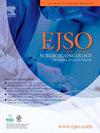机器人辅助甲状腺乳头状癌经腋窝手术中肿瘤大小对肿瘤和手术结果的影响
IF 2.9
2区 医学
Q2 ONCOLOGY
引用次数: 0
摘要
机器人辅助腋窝甲状腺切除术(RATT)已成为分化型甲状腺癌(DTC)的一种远程治疗方法,但关于其对大于3cm肿瘤的肿瘤学疗效的数据,特别是在欧洲队列中,仍然很少。本研究旨在评估按肿瘤大小分层的甲状腺乳头状癌(PTC)患者的RATT手术和肿瘤预后。材料和方法我们回顾性分析了270例组织学证实的PTC患者,这些患者于2012年7月至2022年8月在一个三级中心接受了RATT治疗。根据肿瘤大小将患者分为两组:A组(≥3cm, n = 226)和B组(≥3cm, n = 44)。分析手术结果、并发症发生率和肿瘤参数,包括血清甲状腺球蛋白(Tg)水平、抗甲状腺球蛋白抗体和结构性复发。根据放射性碘消融(RAI)情况进行亚组分析。结果两组患者手术时间、住院时间及术后并发症无显著差异。A组和B组RAI后Tg水平具有可比性(p = 0.999),说明生化反应相似。随访期间仅有1例出现结构性复发(平均48±31个月)。单独行肺叶切除术的患者不论肿瘤大小均无复发迹象。未发现Tg水平的独立预测因子。结论对于PTC,即使肿瘤≥3cm, ratt似乎也是一种安全且肿瘤学有效的方法。这些发现支持在选定的患者中更广泛地使用RATT,不同肿瘤大小的结果具有可比性。需要进一步的多中心随访研究来验证这些结果。本文章由计算机程序翻译,如有差异,请以英文原文为准。
Impact of tumor size on oncological and surgical outcomes in robot-assisted transaxillary surgery for papillary thyroid carcinoma
Background
Robot-assisted transaxillary thyroidectomy (RATT) has emerged as a remote access approach for differentiated thyroid carcinoma (DTC), yet data on its oncological efficacy for tumors larger than 3 cm, particularly in European cohorts, remain scarce. This study aimed to evaluate surgical and oncological outcomes of RATT in patients with papillary thyroid carcinoma (PTC), stratified by tumor size.
Materials and methods
We retrospectively reviewed 270 patients with histologically confirmed PTC who underwent RATT between July 2012 and August 2022 at a single tertiary center. Patients were categorized into two groups based on tumor size: Group A (<3 cm, n = 226) and Group B (≥3 cm, n = 44). Surgical outcomes, complication rates, and oncological parameters—including serum thyroglobulin (Tg) levels, anti-thyroglobulin antibodies, and structural recurrence—were analyzed. Subgroup analysis was conducted based on radioiodine ablation (RAI) status.
Results
No significant differences were observed between groups in terms of operative time, hospital stay, or postoperative complications. Tg levels after RAI were comparable between Group A and Group B (p = 0.999), indicating similar biochemical response. Only one patient experienced structural recurrence during follow-up (mean: 48 ± 31 months). Patients who underwent lobectomy alone showed no evidence of recurrence regardless of tumor size. No independent predictors of Tg levels were identified.
Conclusions
RATT appears to be a safe and oncologically effective approach for PTC, even for tumors ≥3 cm. These findings support the broader use of RATT in selected patients, with outcomes comparable across tumor sizes. Further multicenter studies with longer follow-up are warranted to validate these results.
求助全文
通过发布文献求助,成功后即可免费获取论文全文。
去求助
来源期刊

Ejso
医学-外科
CiteScore
6.40
自引率
2.60%
发文量
1148
审稿时长
41 days
期刊介绍:
JSO - European Journal of Surgical Oncology ("the Journal of Cancer Surgery") is the Official Journal of the European Society of Surgical Oncology and BASO ~ the Association for Cancer Surgery.
The EJSO aims to advance surgical oncology research and practice through the publication of original research articles, review articles, editorials, debates and correspondence.
 求助内容:
求助内容: 应助结果提醒方式:
应助结果提醒方式:


